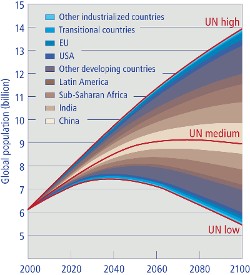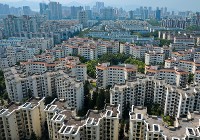Population
& climate
Scientists have long known that changes in population will have some effect on greenhouse gas emissions, but there has been debate as to how large that effect might be.
By mid-century global population could rise by more than three billion people, with most of that increase occurring in urban areas. According to a study published in the Proceedings of the National Academy of Sciences, a slowing of that population growth could contribute to significantly reducing greenhouse gas emissions. The researchers found that if by 2050 population followed one of the slower growth paths foreseen as plausible by demographers at the United Nations, this could provide 16 to 29 percent of the emission reductions thought necessary to keep global temperatures from causing serious impacts. The effect of slower population growth on greenhouse gas emissions would be even larger by the end of the century.
Significantly, the slower population growth will have different effects, depending on where it occurs. For example, a slowing of population growth in developing countries today will have a large impact on future global population size. However, slower population growth in developed countries will be very significant for emission levels because of higher per capita energy use—and thus emissions—in these countries.
The researchers sought to quantify how demographic changes influence emissions over time, and in which regions of the world. They also went beyond changes in population size to examine the links between aging, urbanization, and emissions.
The team found that growth in urban populations could lead to as much as a 25 percent rise in projected carbon dioxide emissions in some developing countries. The increased economic growth associated with city dwellers was directly correlated with increased emissions, largely because of the higher productivity and consumption preferences of an urban labor force.

Global Population. Projected global totals (solid lines) and regional differences (colored bands) for population size. Individual colored bands indicate the contribution of each region to the difference between global scenarios.
Urbanization was identified as particularly important in many developing countries, especially China and India, while aging was considered a significant factor in industrialized countries, where emissions may be reduced by up to 20 percent in certain countries. This is because older populations are associated with lower labor force participation, and the resulting lower productivity leads to lower economic growth.
The researchers worked with projections showing that population aging will occur in all regions of the world, as a result of people living longer and declines in fertility.
Future scenarios of human behavior
The authors developed a set of economic growth, energy use, and emissions scenarios, using PET, a new Population–Environment–Technology computer model. To capture the effects of future demographic change they distinguished between household types, looking at age, size, and urban vs. rural location. In addition, they drew on data from national surveys covering 34 countries and representative of 61 percent of the global population to estimate key economic characteristics of household types over time, including labor supply and demand for consumer goods. The authors comment that households can affect emissions either directly, through their consumption patterns, or indirectly, through their effects on economic growth.
The authors also suggest that developers of future emission scenarios give greater consideration to the implications of urbanization and aging, particularly in the USA, European Union, China, and India.
They caution that their findings do not imply that policies affecting aging or urbanization should be implemented as a response to climate change, but rather that a better understanding of these trends would help future changes to be anticipated.
Further information: O’Neill BC, Dalton M, Fuchs R, Jiang L, Pachauri S, Zigova K (2010). Global demographic trends and future carbon emissions. PNAS 107(41): 17521–17526.
Note: This study was initiated by IIASA and supported primarily by funding from the European Heads of Research Councils and the European Science Foundation’s European Young Investigators award (EURYI). The study was conducted by researchers from the National Center for Atmospheric Research (NCAR), the International Institute for Applied Systems Analysis, and the National Oceanographic and Atmospheric Administration. Funding was also received from the Hewlett Foundation and the U.S. National Science Foundation.
CONTACT DETAILS
Read this issue of Options magazine


